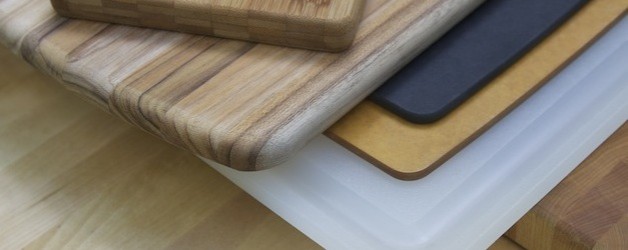

Great Gear Makes All Your Kitchen Tasks Easier
Cutting boards are used so consistently for every meal that they become almost invisible. The right cutting board, though, can go a long way to making it more efficient to cook and clean up, as well as keep your family healthy by reducing the risk of food contamination. Perhaps your cutting boards have become tired, or you never had good ones to start with. A little maintenance for your current boards, or some new ones that work better in your kitchen, will get your fall meals off to a good start.
Happy chopping!
Choosing a Cutting Board
It is a good idea to have at least two cutting boards in your kitchen: one for raw chicken and meats, and another for everything else. Raw meats, especially chicken, can easily contaminate other foods if you are not careful about how you handle them during prep. We like to use one side of the board for chicken, and the second side for other raw meats. Make sure it is clearly labeled so others in your family know which boards to use as well.
- Material
- Plastic: The biggest advantages to plastic boards is that they can go in the dishwasher, and they are easy to manage. You can get ones in different colors, or pre-labeled, to remember which to use for meats and vegetables. (from Kimberly’s kitchen: I use a permanent marker to label my plastic boards.) Once you start to notice deep cuts and scratches in the surface, though, it is time to replace them. Those deeper gouges are where bacteria and odors will get trapped even after getting run through the dishwasher.
- Wood: There are lots of choices when it comes to wood boards: traditional hard-wood boards in either butcher block (the checkerboard pattern) or edge-grain (parallel lines); teak, bamboo. Traditional wood boards are usually made from hard woods like maple, walnut, and cherry since they are less porous; they have greater longevity and withstand bacteria and odor better. The difference between a butcher block or edge-grain board is essentially an aesthetic one, although butcher block boards are thought to be more knife-friendly since the wood fibers are exposed and more forgiving. Nothing beats the look, feel, heft, and knife-friendly surface of a large wood cutting board, but with the maintenance required to keep them in good shape, we recommend smaller wood boards. We have read positive reviews lately of teak wood cutting boards since they require less conditioning with mineral oil (see below) than bamboo or traditional wood boards. If you decide to go with a wood cutting board, make sure to stay away from thin wood boards, since they can easily warp. Another major deciding factor when deciding on whether to purchase wood cutting boards is that they cannot go in the dishwasher. When maintained properly, though, they can last for many years.
- Composites: In this category we include wood fiber composite boards, since they don’t require the same maintenance as traditional wood boards and can be put in the dishwasher. Epicurean is a prominent brand of wood fiber boards that are attractive and easy to use.
- Size
- Think storage and cleaning when choosing what size board to get. It is always frustrating to get something for your kitchen that is difficult to store or clean. If you choose something that can be put in the dishwasher, make sure it will fit. If you have a wood board, then make sure it can fit in your sink on end, or at least be manageable to clean.
- We like boards that are 15×20 inches and a few smaller ones for quick cutting and cleaning.
- Stability
- Having a cutting board move around while you are chopping something is not only frustrating, it is unsafe. Choose boards that have some weight, or at least “anchor” them to the counter with a dampened kitchen towel. You can also use a piece of shelf liner under the board — a trick we learned a long time ago from Alton Brown (having that piece of shelf liner in the kitchen can also come in handy when you need some extra traction to open jars!).
Use and Care
There isn’t much maintenance for plastic or composite boards since they can go directly into the dishwasher, but sometimes staining and lingering odors need to be tackled. Wood boards also have the same issues, so we’ve included tips for how to deal with stains and odors on both surfaces. For plastic boards, keep an eye on the surfaces over time so you can replace them when necessary.
- Wood board care: After use, rinse off the surface of the board, then use hot, soapy water to clean. (Never submerge a wood board in water because it will warp.) Let the board dry completely before putting it away. Every few weeks, condition the surface of the board with food-grade mineral oil (easy to find in grocery or hardware stores). Use a soft towel to wipe the oil in, then remove the excess that doesn’t get absorbed. This will prevent the wood from drying out and shrinking, which can cause cracking and warping of the board. Wood boards can be sanded and re-finished if they have multiple cuts or are dried out.
- Clean stains and odors: Sprinkle coarse salt into the board, then rub with a lemon half, and rinse. It is a good idea to this every few weeks with any kind of board.
- Disinfect: Use full-strength white vinegar to disinfect and clean. Wet a paper towel with vinegar, wipe, and let dry.
- Sanitize: Keep this solution we learned about from Alton Brown handy in a clearly labeled spray bottle. You can use it to sanitize other surfaces and tools as well. Combine 1 ½ teaspoons Clorox bleach per 1 pint water. Spray the surface and allow to dry.
- Other Uses: In addition to the usual food prep duties of chopping and assembly, cutting boards make excellent serving platters and display boards for buffets.
